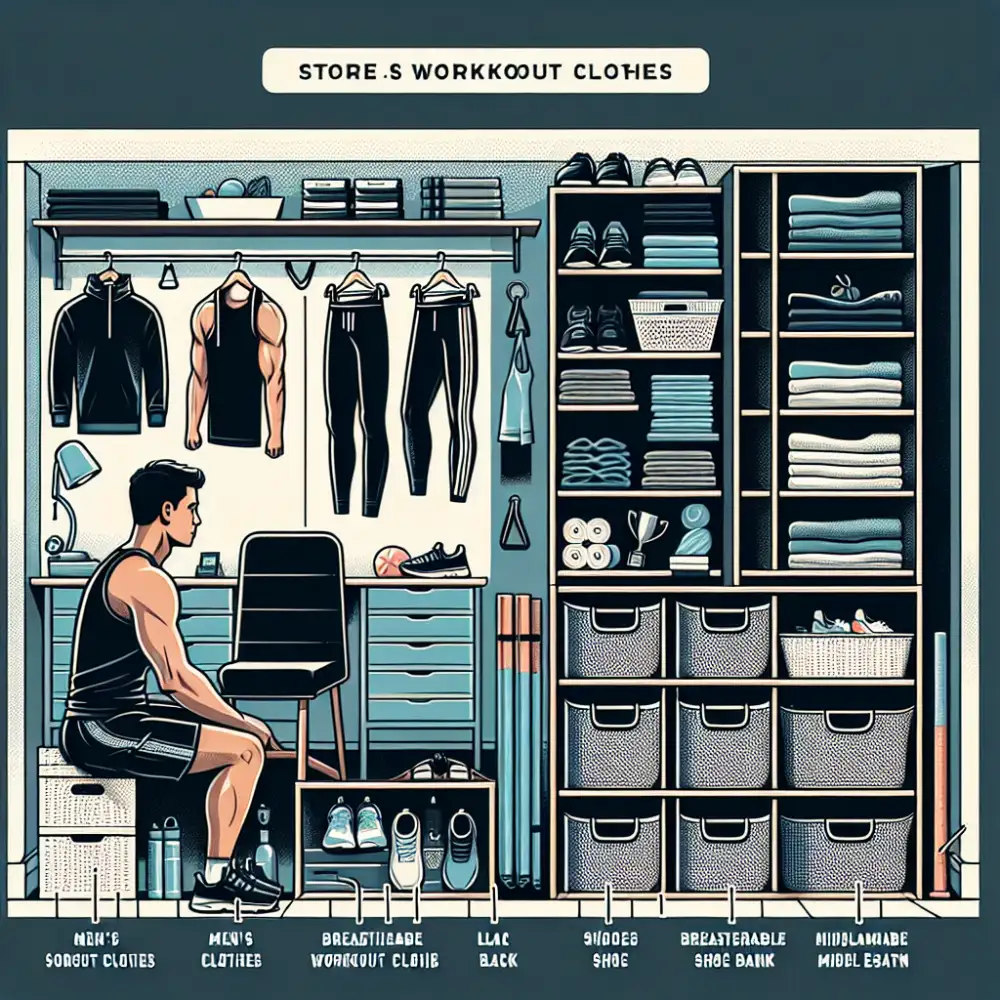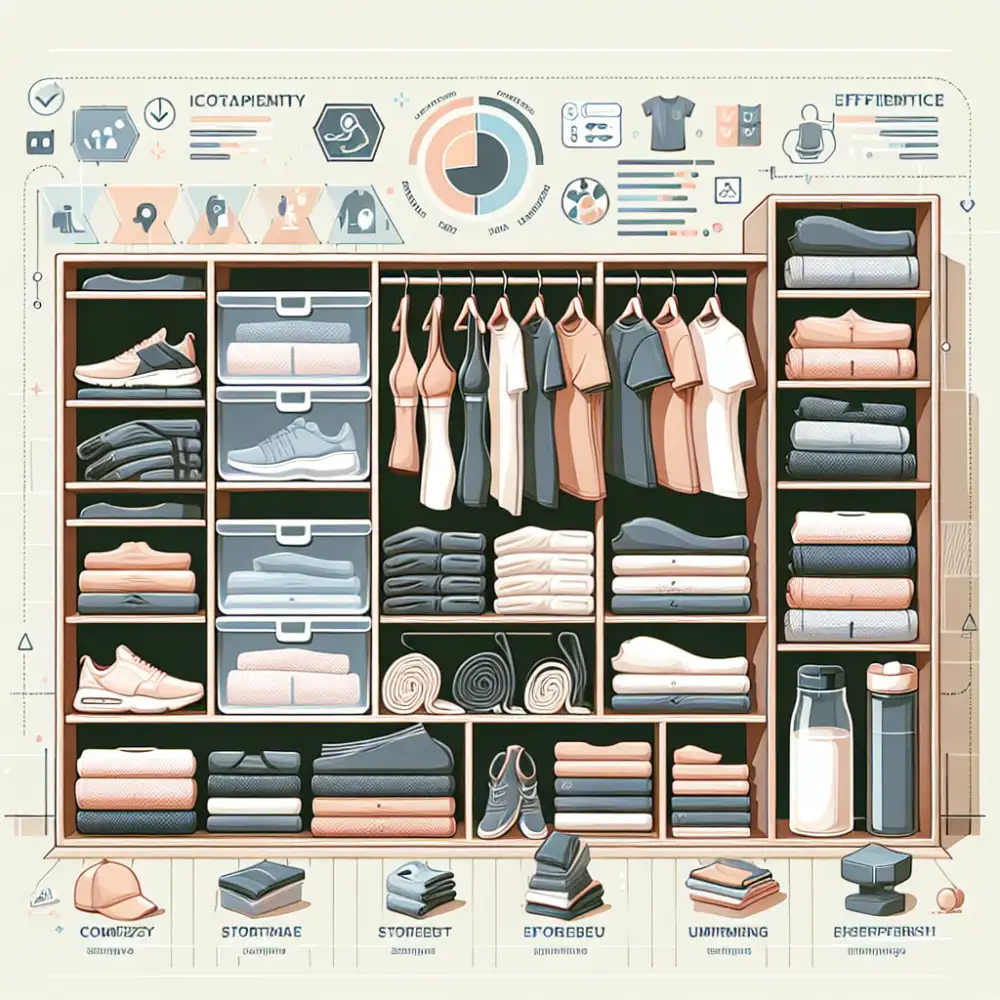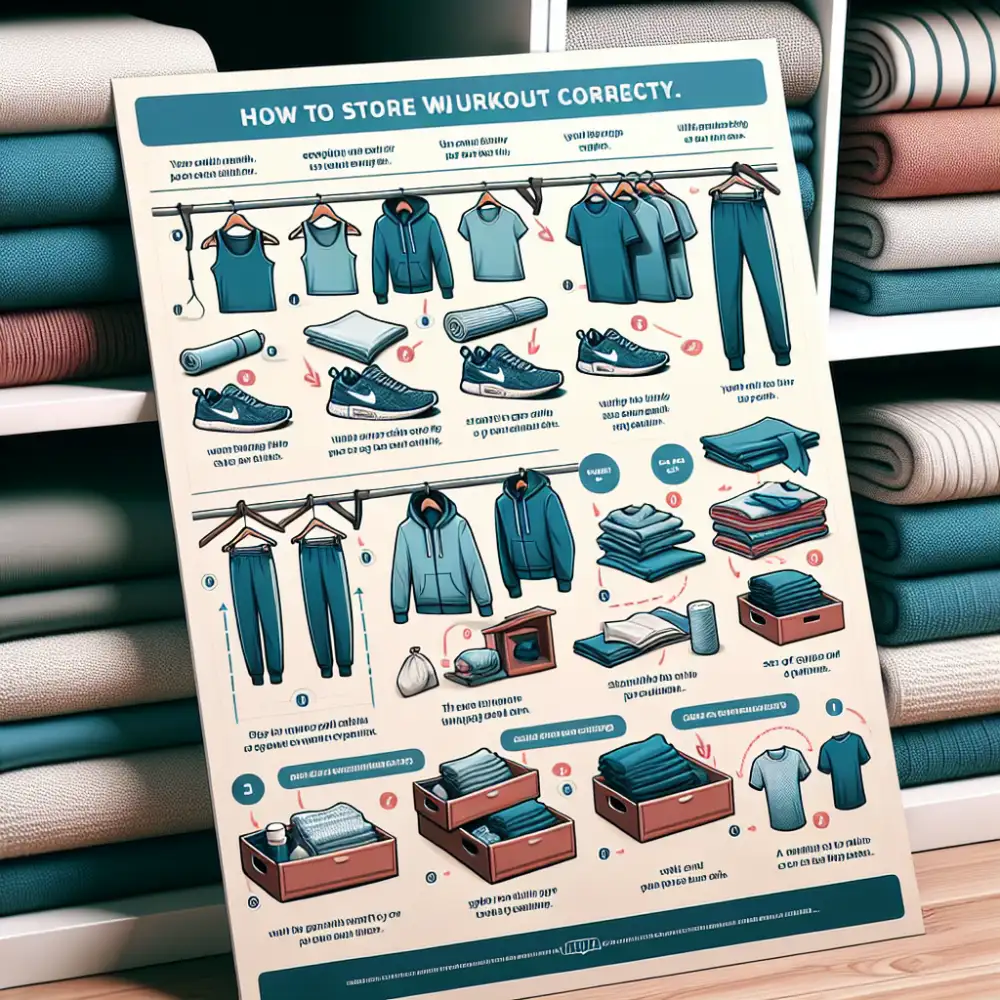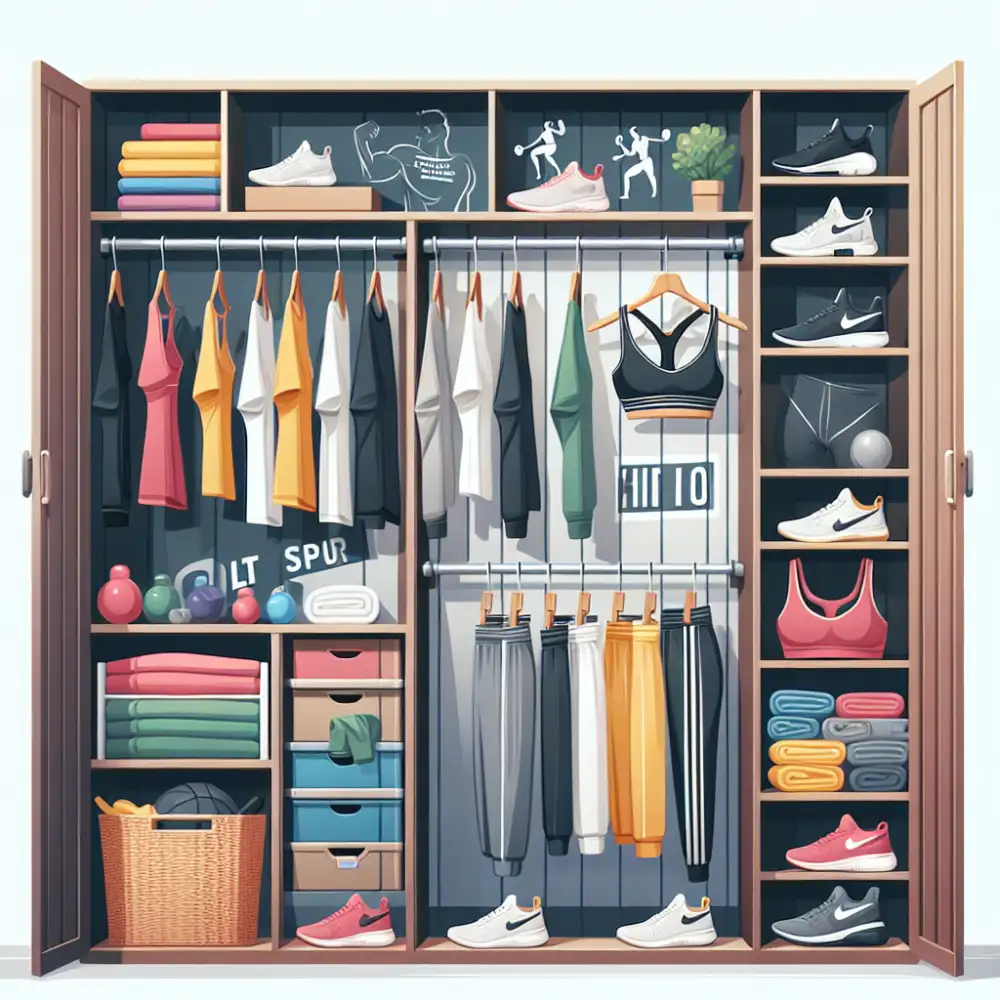Workout Clothes Storage Hacks for Fitness Fanatics

- Wash after every use
- Choose breathable fabrics
- Fold or hang properly
- Avoid wire hangers
- Use separate laundry basket
- Store in cool, dry place
- Don't overpack your gym bag
- Air out sweaty clothes immediately
- Use odor absorbers
- Organize by activity or season
- Utilize drawers and shelves
- Consider vacuum-sealed bags
- Regularly declutter your collection
- Repair or replace damaged items
Wash after every use
We know, we know — it’s tempting to toss your sweaty clothes in a hamper and forget about them. But trust us on this one. Sweat creates the perfect breeding ground for bacteria, which can lead to odor and even skin irritation. Plus, the longer you wait to wash your workout clothes, the harder it will be to get rid of the smell. So do yourself (and your nose) a favor and toss those sweaty clothes in the wash after every single workout. Your clothes (and your gym buddies) will thank you.
Choose breathable fabrics
When it comes to storing your workout clothes, choosing breathable fabrics is key to preventing that dreaded mildew smell. Natural fabrics like cotton, bamboo, and merino wool are great at allowing air to circulate, which helps to dry out sweat and moisture. These fabrics are also naturally antimicrobial, which means they resist the growth of odor-causing bacteria.
While technical fabrics like polyester and nylon are great for wicking away moisture during your workout, they tend to trap odors more easily. If you prefer these fabrics, look for options that have antimicrobial properties or mesh panels for added breathability. Avoid storing your workout clothes in plastic bags or airtight containers, as this can trap moisture and create a breeding ground for bacteria. Instead, opt for open baskets, shelves, or drawers.
Fold or hang properly
When it comes to your workout gear, proper storage can extend its lifespan and keep it looking its best. Folding or hanging your clothes strategically can prevent wrinkles, creases, and stretching. For workout tops and t-shirts, folding them neatly is usually the best approach. Lay the garment flat, fold it in half vertically, and then fold it again horizontally. This method helps maintain the shape of the garment and maximizes storage space in drawers.
Tank tops and sports bras, with their thinner straps, are often better suited for hanging. Use padded hangers to prevent the straps from stretching out. Fold leggings, shorts, and sweatpants in half lengthwise and then fold them in half or thirds crosswise. This method helps prevent wrinkles and creases. Avoid hanging these items, as it can lead to stretching over time.
Avoid wire hangers
Wire hangers are the worst offenders when it comes to storing your workout clothes. They can stretch out the shoulders of your tank tops and leave unsightly creases in your leggings. Instead, opt for padded hangers, sturdy plastic hangers, or even folding your clothes and storing them in drawers. This will help your workout wear keep its shape and last longer.
Use separate laundry basket
Designate a separate laundry basket or hamper specifically for your workout clothes. This prevents the spread of bacteria and odor to your other clothes. Choose a basket with good ventilation to allow the clothes to air out and prevent mildew growth. You can further enhance airflow by using a laundry basket with holes or a mesh construction.

Store in cool, dry place
Workout clothes, especially those made with moisture-wicking materials, need to breathe. Avoid storing them in damp, dark places like your gym bag or a plastic bag. These environments are breeding grounds for bacteria and can lead to unpleasant odors and even damage the fabric. Instead, always allow your workout clothes to air dry completely before putting them away. This helps prevent the growth of odor-causing bacteria and keeps your clothes smelling fresh. Once dry, store your workout clothes in a cool, dry place like a drawer or closet.
Avoid hanging workout clothes, especially those made with elastic fibers, as this can cause them to stretch out of shape. Folding them and storing them flat is a better option to maintain their shape and elasticity. If you are short on drawer space, consider using storage bins or baskets to keep your workout clothes organized and easy to find. Choose bins with ventilation holes to allow for air circulation.
Treat your workout gear like the high-performance apparel it is: launder with care, fold to prevent creasing, and store in a cool, dry place to keep them fresh and ready for action.
Esme Beaumont
Don't overpack your gym bag
It's tempting to stuff your gym bag with multiple outfit options and enough toiletries to rival your bathroom sink. But trust us, a streamlined gym bag is a happier gym bag. Start by choosing workout clothes that can do double duty. Look for moisture-wicking fabrics that dry quickly, allowing you to wear them for multiple workouts before washing. When it comes to packing, roll your clothes instead of folding them. This saves space and prevents wrinkles. Invest in some small, reusable containers for toiletries like shampoo, conditioner, and body wash.
Ditch the bulky bath towels and opt for a microfiber towel that takes up a fraction of the space. Once you're home from the gym, unpack your bag immediately. Don't let sweaty clothes fester! Toss them in the laundry and let your bag air out to prevent odors. By packing smart and staying organized, you can keep your gym bag light, fresh, and ready for action.
Air out sweaty clothes immediately
Don't let your hard work at the gym turn into a breeding ground for bacteria and odor. After an intense workout, your clothes are soaked in sweat, creating the perfect environment for bacteria to multiply. This leads to that dreaded gym bag smell and can even shorten the lifespan of your workout gear. As soon as you're done with your workout, resist the urge to throw your sweaty clothes in a pile or stuff them in your gym bag. Instead, hang them up or lay them flat in a well-ventilated area. This allows the moisture to evaporate quickly, preventing the growth of odor-causing bacteria. If you're short on time, toss your sweaty clothes in the dryer on a low heat, air-dry setting for a few minutes. This will help to remove excess moisture and keep your clothes smelling fresh. Remember, taking a few extra minutes to air out your sweaty clothes can make a big difference in keeping your workout gear fresh, hygienic, and long-lasting.

Use odor absorbers
One of the simplest ways to keep your workout clothes smelling fresh is to use odor absorbers. These come in various forms, each with its own set of benefits:
Baking soda: A classic odor neutralizer. Place an open box or bowl of baking soda in your gym bag or drawer to absorb moisture and odors.
Activated charcoal: Similar to baking soda, activated charcoal is highly porous and effectively traps odors. Look for charcoal bags specifically designed for odor absorption.
Dryer sheets: While primarily used for laundry, dryer sheets can also freshen up your gym bag. Toss a new sheet in after each workout to combat lingering smells.
Commercial odor absorbers: Many sports stores sell odor-absorbing products specifically for gym bags and shoes. These often come in convenient pouches or balls and can be particularly effective against strong odors.
Remember to replace your chosen odor absorber regularly, as their effectiveness diminishes over time. By incorporating odor absorbers into your storage routine, you can keep your workout gear smelling fresh and ready for your next workout.
Organize by activity or season
One smart approach to storing your workout gear is to organize it based on the activity or the season. Think about how you actually use your clothes. You could have a separate drawer or bin for running gear, another for yoga or Pilates, and yet another for strength training or cross-training. This makes it super easy to grab what you need for a particular workout without digging through a jumbled mess.
| Storage Method | Pros | Cons | Best For |
|---|---|---|---|
| Drawer Folding | Easy access, keeps clothes relatively wrinkle-free | Can be bulky, harder to see all items at once | Everyday workout gear, t-shirts, shorts |
| Hanging | Great for wrinkle-prone items, easy to browse | Takes up closet space, can stretch out some fabrics | Delicate fabrics, workout dresses, dressy athletic wear |
| Storage Bins with Labels | Ideal for off-season items, maximizes space | Items at the bottom can be hard to reach | Seasonal workout gear, bulky items like jackets or sweatshirts |
| Mesh Laundry Bags | Keeps dirty clothes separate, breathable to prevent odor | Doesn't organize clean clothes | Used workout clothes, sweaty items needing to air out |
If you tend to switch up your workout routine with the seasons, consider rotating your workout clothes accordingly. Pack away bulky sweaters and fleece-lined leggings during the warmer months and bring them to the front of your workout wardrobe when the temperature drops. This way, you'll maximize your storage space and always have the right gear within easy reach.

Utilize drawers and shelves
Drawers and shelves are your best friends when it comes to storing workout clothes. Foldable items like t-shirts, tank tops, and shorts can be neatly stacked in drawers to maximize space. Consider using drawer dividers to separate items by category or workout type. For instance, you can designate one section for tops, another for bottoms, and a third for sports bras and socks. This makes it easy to find what you need without rummaging through the entire drawer. If you prefer shelves, fold your workout clothes using the KonMari method or another space-saving technique. This not only keeps your shelves tidy but also allows you to see all your options at a glance. You can further organize your shelves by using baskets or bins to store smaller items like resistance bands, headbands, and workout gloves.
Drawers and shelves are your best friends when it comes to storing workout clothes. Foldable items like t-shirts, tank tops, and shorts can be neatly stacked in drawers to maximize space. Consider using drawer dividers to separate items by category or workout type. For instance, you can designate one section for tops, another for bottoms, and a third for sports bras and socks. This makes it easy to find what you need without rummaging through the entire drawer. If you prefer shelves, fold your workout clothes using the KonMari method or another space-saving technique. This not only keeps your shelves tidy but also allows you to see all your options at a glance. You can further organize your shelves by using baskets or bins to store smaller items like resistance bands, headbands, and workout gloves.
Consider vacuum-sealed bags
Vacuum-sealed bags are a great option for long-term storage or if you have limited storage space. These bags remove all the air, significantly reducing their volume. This compression not only saves space but also helps to protect your clothes from moisture, dust, and pests. Just be sure to fold your workout clothes neatly before sealing them to prevent wrinkles. And remember, while this method is great for long-term storage, it's not ideal for clothes you'll need to access frequently, as you'll need to reseal the bag each time.

Regularly declutter your collection
Regularly decluttering your workout clothes is as important as any other tip for storing them. Over time, we tend to accumulate a lot of clothes. Some items get worn out, lose their shape, or no longer spark joy when you put them on. Holding onto these items not only takes up precious space but can also make it harder to find the workout gear you actually love and use. Set aside time every few months to go through your workout clothes. Get rid of anything that's stained, ripped, or permanently stretched out. If you haven't worn something in six months to a year, it's probably time to say goodbye. Donate old workout clothes to local charities or thrift stores. This way, you give your clothes a second life and free up space in your drawers and closet for new favorites. Remember, a well-organized workout wardrobe can motivate you to stay active and make finding your gear a breeze.
Repair or replace damaged items
Before you even think about storing your workout clothes, take a moment to assess their condition. Got a hole in your favorite yoga pants? A loose seam on your go-to sports bra? Don't just shove them in a drawer and forget about them! Take the time to repair any minor damages. A little sewing or fabric glue can go a long way in extending the life of your workout gear. For more serious damage, consider whether the item is worth repairing or if it's time to bid it farewell. There's no point in storing clothes you'll never wear again. Plus, letting go of worn-out items gives you an excuse to treat yourself to some new workout gear!
Published: 13. 07. 2024
Category: Food



